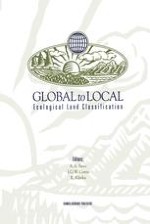1996 | OriginalPaper | Chapter
Forest Dynamics Modelling under Natural Fire Cycles: A Tool to Define Natural Mosaic Diversity for Forest Management
Authors : Sylvie Gauthier, Alain Leduc, Yves Bergeron
Published in: Global to Local: Ecological Land Classification
Publisher: Springer Netherlands
Included in: Professional Book Archive
Activate our intelligent search to find suitable subject content or patents.
Select sections of text to find matching patents with Artificial Intelligence. powered by
Select sections of text to find additional relevant content using AI-assisted search. powered by
In natural boreal forests, disturbances such as fire and variation in surficial deposits create a mosaic of forest stands with different species composition and age. At the landscape level, this variety of stands can be considered as the natural mosaic diversity. In this paper, we describe a model that can be used to estimate the natural diversity level of landscapes. We sampled 624 stands for tree species composition and surficial deposits in eight stand-age classes corresponding to eight fire episodes in the region of Lake Duparquet, Abitibi, Québec at the southern fringe of the Boreal Forest. For six surficial deposit types, stand composition data were used to define equations for vegetation changes with time for a chronosequence of 230 years for four forest types. Using Van Wagner’s (1978) model of age class distribution of stands, the proportion of each forest type for several lengths of fire cycle were defined. Finally, for real landscapes (ecological districts) of the ecological region of the “Basses-Terres d’Amos”, the proportion of forest types were weighted by the proportion of each surficial deposit type using ecological map information. Examples of the possible uses of the model for management purposes, such as biodiversity conservation and comparisons of different landscapes in terms of diversity and sensitivity to fire regime changes, are discussed.
